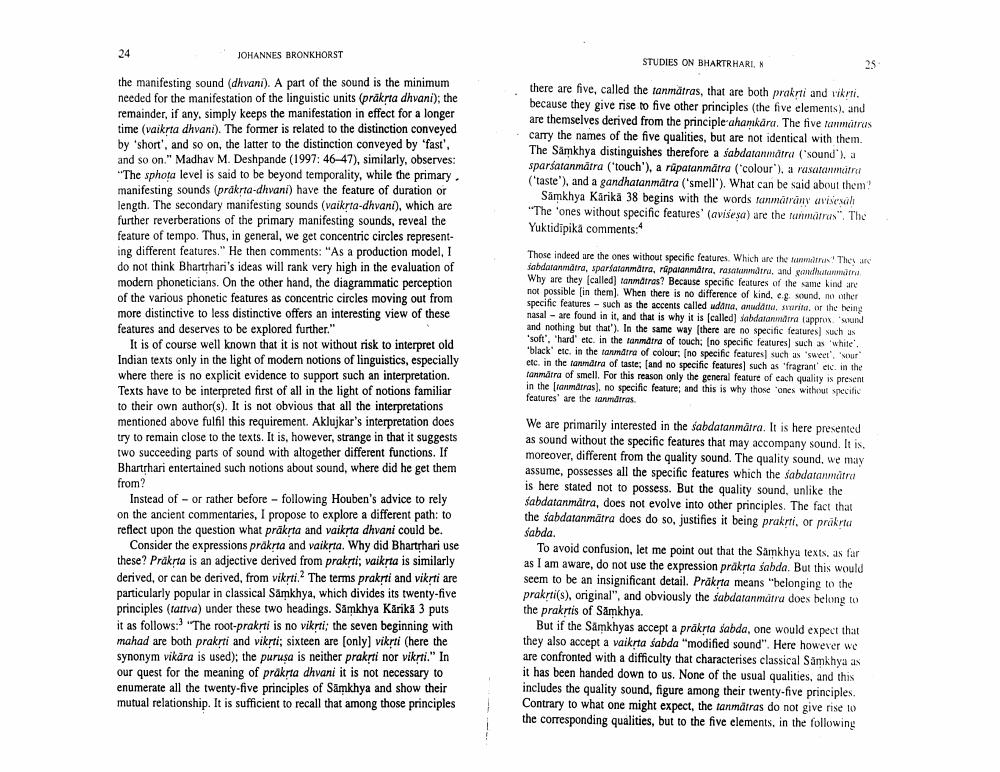Book Title: Studies On Bhartahari And Prakrta Dhvani And Samkhya Tanmatras Author(s): Johannes Bronkhorst Publisher: Johannes Bronkhorst View full book textPage 2
________________ JOHANNES BRONKHORST STUDIES ON BHARTRHARI, there are five, called the tanmatras, that are both prakrti and wiki. because they give rise to five other principles (the five elements), and are themselves derived from the principle ahamkara. The five hundrus carry the names of the five qualities, but are not identical with them. The Samkhya distinguishes therefore a sabdatanmärra (sound'), a sparsatanmatra ("touch"), a rüpatanmätra ("colour), a rasatanut ("taste"), and a gandhatanmatra ("smell"). What can be said about them! Samkhya Karika 38 begins with the words tanmatrūny avisenal "The ones without specific features' (avisesa) are the fannirus". The Yuktidipika comments: the manifesting sound (dhvani). A part of the sound is the minimum needed for the manifestation of the linguistic units (prakrta dhvani); the remainder, if any, simply keeps the manifestation in effect for a longer time (vaikrta dhvani). The former is related to the distinction conveyed by 'short', and so on, the latter to the distinction conveyed by 'fast, and so on." Madhav M. Deshpande (1997: 46-47), similarly, observes: "The sphora level is said to be beyond temporality, while the primary. manifesting sounds (prakrta-dhvani) have the feature of duration or length. The secondary manifesting sounds (vaikrta-dhvani), which are further reverberations of the primary manifesting sounds, reveal the feature of tempo. Thus, in general, we get concentric circles representing different features." He then comments: "As a production model, do not think Bhartrhari's ideas will rank very high in the evaluation of modem phoneticians. On the other hand, the diagrammatic perception of the various phonetic features as concentric circles moving out from more distinctive to less distinctive offers an interesting view of these features and deserves to be explored further. It is of course well known that it is not without risk to interpret old Indian texts only in the light of modem notions of linguistics, especially where there is no explicit evidence to support such an interpretation. Texts have to be interpreted first of all in the light of notions familiar to their own author(s). It is not obvious that all the interpretations mentioned above fulfil this requirement. Aklujkar's interpretation does try to remain close to the texts. It is, however, strange in that it suggests two succeeding parts of sound with altogether different functions. If Bharthari entertained such notions about sound, where did he get them from? Instead of or rather before - following Houben's advice to rely on the ancient commentaries, I propose to explore a different path: to reflect upon the question what prakrta and vaikrta dhvani could be. Consider the expressions prakrta and vaiksta. Why did Bharthari use these? Prakrta is an adjective derived from prakrti; vaikyta is similarly derived, or can be derived from vikti? The terms prakti and vikyti are particularly popular in classical Samkhya, which divides its twenty-five principles (rattva) under these two headings. Samkhya Karika 3 puts it as follows: "The root-prakrti is no vikti: the seven beginning with mahad are both prakrti and vikti; sixteen are [only] vikti (here the synonym vikara is used); the purusa is neither prakti nor vikti." In our quest for the meaning of prakrta dhvani it is not necessary to enumerate all the twenty-five principles of Samkhya and show their mutual relationship. It is sufficient to recall that among those principles Those indeed are the ones without specific features which are the fun ! These Sabdarandra, sparsanmdira, rapatan dira, rasad u, and whe n Why are they called tantras? Because specific features of the same kind are not possible in them). When there is no difference of kind, eg sound, either specific features such as the accents called udara, and it suit, or the being nasal - are found in it, and that is why it is called) sabda andra approx. sound and nothing but that'). In the same way (there are no specific features such as 'soft', 'hard' etc. in the lanmdtra of touch: (no specific features such as 'white' 'black' etc, in the tanmatre of colour: (no specific features such as 'sweet 'Mour etc. in the fanm.dira of taste; (and no specific features such as 'fragrant' eld in the tanmärra of smell. For this reason only the general feature of each quality is present in the ranimiras), no specific feature, and this is why those ones without specific features are the landıras. We are primarily interested in the sabdatanmätra. It is here presented as sound without the specific features that may accompany sound. It is moreover, different from the quality sound. The quality sound, we may assume, possesses all the specific features which the sabdatanmatu is here stated not to possess. But the quality sound, unlike the sabdatanmätra, does not evolve into other principles. The fact that the sabdatanmätra does do so, justifies it being prakrti, or pruiktu sabda. To avoid confusion, let me point out that the Samkhya texts, as far as I am aware, do not use the expression prakrta sabda. But this would seem to be an insignificant detail. Prakrta means "belonging to the prakrti(s), original", and obviously the sabdatanmätra does belong to the praktis of Samkhya. But if the Samkhyas accept a prakrta sabda, one would expect that they also accept a vaiksta sabda "modified sound". Here however we are confronted with a difficulty that characterises classical Samkhya as it has been handed down to us. None of the usual qualities, and this includes the quality sound, figure among their twenty-five principles Contrary to what one might expect, the tanmdiras do not give rise 10 the corresponding qualities, but to the five elements, in the followingPage Navigation
1 2 3 4 5 6
